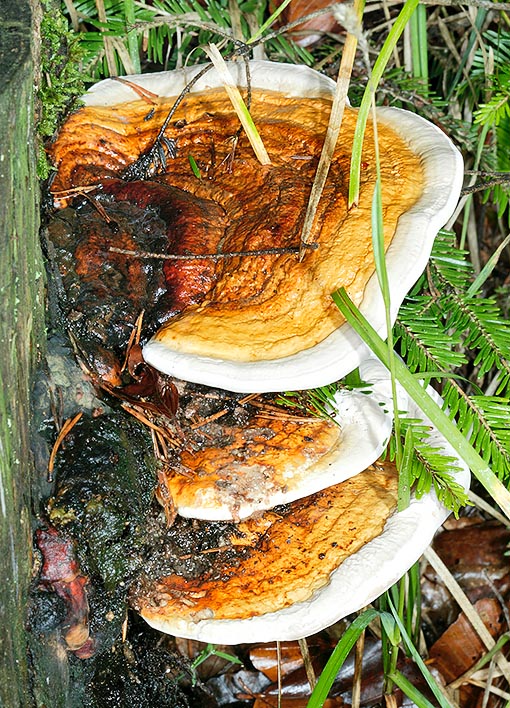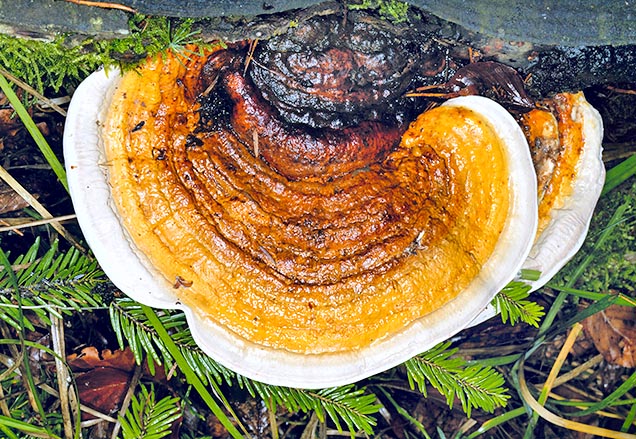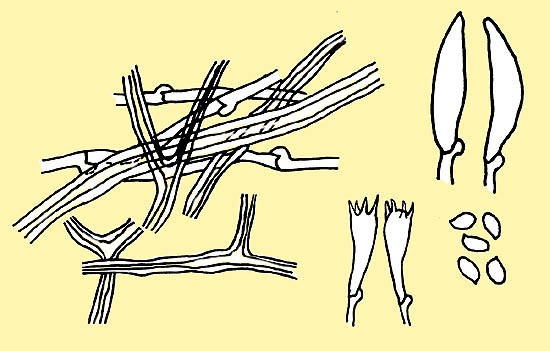
Text © Massimiliano Berretta

English translation by Mario Beltramini

Fomitopsis pinicola basidiomes are usually overlapped © Giuseppe Mazza
Family: Fomitopsidaceae Jülich, 1982.
Genus: Fomitopsis Karsten, 1881.
Fomitopsis pinicola (Swartz : Fries) Karsten, 1889.
The term comes from the Latin “pinícolus” = which lives among the pines, (Latin pinus, pini = pine + colo = I live).
In Italy it is commonly called “poliporo marginato”; in Spain “yesquero del pino”; in France “amadouvier de pins”, “unguline marginée”; in Germany “Fichten-Porling”; in the UK “red banded polypore”, “brown crumbly”, “rot fruiting bodies”.
Description of the genus
To the genus Fomitopsis are ascribed pluriennial basidiomes, at times even annual, sessile, growing on the wood, of mainly woody consistency; smooth sterile surface, zonate or grooved with distinct cutis; white, cream or pink context, with concolorous tubules and pores. The hyphal system is trimitic, the structural and connective hyphae have a range of colours going from hyaline to yellow, hyaline generative hyphae with thin wall and with clamp connections; absence of cystidia; hyaline cylindrical-ellipsoidal basidiospores with thin wall, smooth, inamyloid.
The species belonging to this genus cause the brown rot, on conifers and broad-leaved trees. Species typus: Fomitopsis pinicola (Swartz : Fries) Karsten 1889.
Description of the species
Cap: perennial basidiomes, flattened, isolated or overlapped, woody, from 10 to 30 cm long; whitish and wavy margins with zonate pileus surface, lacquered, blackish brown in the part adhering to the substratum, yellowish or reddish in the marginal part, often, in the fresh specimens, are present drops of guttation.
Hymenium: porous, cream white, yellowish if rubbed, with 4-3 pores per mm, roundish and pluristratified cream-ochreous tubules, the last year ones being paler.
Stipe: absent.
Flesh: context concolorous to the tubules, coriaceous and woody, up to 10-12 cm thick, showily fibrous when broken. Unpleasant smell, fresh taste, sourish.

Conifers saprophyte, looks lacquered, with thick wavy white margin © Giuseppe Mazza
Habitat: usually saprophytic rarely parasitic, it grows on conifers, especially Picea, in the mountain as well as in the plain, rarely on broadleaf trees.
Edibility: inedible because too woody.
Reactions: context and tubules become red with the KOH in the young specimens, vinous or black in the ripe or exsiccated ones.
Microscopy: trimitic hyphal system, hyaline thin-walled generative hyphae, with clamp connections, of 2,5-3,5 µm of diameter; frequent skeletal thick-walled hyphae, yellowish, of 3-6 µm of diameter; frequent binding hyphae but difficult to observe, thick-walled and with short lateral branches, of 3-5 µm of diameter. Tetrasporic clavate basidia, with basal clamp connections, 18-22 × 6,5-8 µm. Cylindrical-ellipsoidal basidiospores, hyaline, smooth, thin-walled, bent on one side, more or less neatly apiculate, inamyloid, 6-8 × 3-4 µm.
Remarks: it is a widely distributed species, common in all Europe, in Asia, in North America and in Africa. The pileus surface is covered by a crusty layer which dissolves with the potash and melts when heated.

Fomitopsis pinicola generative and binding hyphae, basidia, cystidioles and spores © Angeli
The activity of the brown rot produces abundant woody residuals which are very important being stable components of the soil of the coniferous forests.
It can be mistaken with Perenniporia fraxinea (Bulliard) Ryvarden 1978, which has a tuberculate pileus surface, not lacquered, grey-brownish, ochreous porous surface with pink hues, growing only on broad-leafs; Fome pinicola when old can be mistaken with Fome fomentarius (Linnaeus) Fries, 1849, which, however, has grey surface, paler margin, greyish pores and bigger spores. Other possibility of mistake stands with. Altra possibile confusione si può avere con Fome rosea (Albertini & Schweinitz) P. Karsten 1881, which, however, grows mostly on the beech, has dark grey surface, before shiny then opaque and pink hymenium. Some species of the genus Ganoderma Karsten 1881, presenting a lacquered surface, but never with the colourations of Fome pinicola, and the spore print is brown-reddish en masse, may create a possible confusion.
Synonyms
Boletus pinicola Swartz 1810 (basionym); Fomes pinicola (Swartz) Fries 1849; Placodes pinicola (Swartz) Patouillard 1887; Polyporus pinicola (Swartz) Fries 1821; Pseudofomes pinicola (Swartz) Lázaro Ibiza 1916; Trametes pinicola (Swartz) P. Karsten 1882; Ungulina pinicola (Swartz) Singer 1929.
→ For general notions about Fungi please click here.
→ To appreciate the biodiversity of MUSHROOMS please click here.
